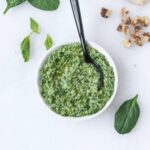Choking is a concern for all babies, regardless of feeding method. Lower the risk of choking by avoiding these top choking hazard foods.

Every parent first starting solids is concerned about choking - it's totally normal to feel nervous! But you don't have to let the fear of choking stop you from helping your baby explore new tastes and textures. Arm yourself with some safety knowledge, including knowing the top choking hazards to avoid, so that you can stress less and enjoy the journey of starting solids more!
Jump to:
What Is Choking?
Choking is when baby's airway is obstructed, causing trouble breathing or blockage of breath. If your baby is choking, immediate intervention is required. Call 9-1-1 on and perform infant CPR. Signs of choking include:
- Inability to cry or make noise
- Difficulty breathing: heavy wheezing or gasping
- Inability to cough or very weak/ineffective cough
- Look of panic or terror
- Tugging at chest
- Blue tint of skin or lips
- High pitched noise
Gagging, on the other hand, is a normal and protective reflex where the back of the throat closes, preventing swallowing. The food is pushed forward to the front of the mouth and will often drop or be spit out. Gagging happens often as babies learn to eat, and could be accompanied by watery eyes, crying, facial redness, drooling, spitting, and/or vomiting.
Do BLW Babies Choke More?
Unfortunately any baby can choke on any object. Research shows that BLW babies are at no higher risk of choking than spoon-fed babies. In fact, spoon-fed babies may choke more on finger foods and lumpy purees. In both groups, choking episodes are most likely to occur when unsafe foods (choking hazards) are given to baby. That's why it's important to only offer safe foods that are an appropriate shape and texture.

Foods To Avoid To Reduce Risk of Choking
To prevent choking, familiarize yourself with the foods that pose a choking hazard and avoid giving them to your baby, regardless of feeding method. These include hard foods, round foods or 'coins', tough or dry foods, and foods that are too thick. Don't feed your baby:
- Raw carrots or raw apple slices/chunks
- Foods cut into coin shapes
- Whole nuts or dried fruit, such as raisins
- Whole grapes or cherry tomatoes (or some very large blueberries)
- Popcorn
- Hard candies
- Hot dogs or similar sausages
- Thick peanut butter
- Marshmallows
- Dry, crusty bread
- Very soft white bread that will become gummy in the mouth
- Tough, fibrous meats (such as bacon, ham, or jerky)
- Raw leafy greens
- Chips
Other Steps You Can Take
Besides avoiding the unsafe foods above, here are few things you can do to keep your baby safe:
- ALWAYS make sure there is an adult present and paying attention to baby any time he or she eats. This is the number on safety rule.
- Make sure baby is upright and in the high chair or in your lap while eating - no slouching, slumping, or laying down with food.
- Take an infant CPR class to make sure you know the basics. They may even offer them at the hospital where you will/did give birth!
- Never put food in the baby's mouth with your hands. Let baby be in control of bringing food to his or her mouth.
- Never reach in a baby's mouth if they are choking. This could push the object further in.
Be sure to read how to modify recipes for BLW and the safety guidelines for serving all foods to babies before beginning baby led weaning!

















Leave a Reply